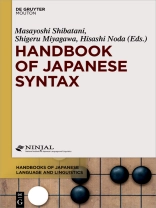Studies of Japanese syntax have played a central role in the long history of Japanese linguistics spanning more than 250 years in Japan and abroad. More recently, Japanese has been among the languages most intensely studied within modern linguistic theories such as Generative Grammar and Cognitive/Functional Linguistics over the past fifty years. This volume presents a comprehensive survey of Japanese syntax from these three research strands, namely studies based on the traditional research methods developed in Japan, those from broader functional perspectives, and those couched in the generative linguistics framework.
The twenty-four studies contained in this volume are characterized by a detailed analysis of a grammatical phenomenon with broader implications to general linguistics, making the volume attractive to both specialists of Japanese and those interested in learning about the impact of Japanese syntax to the general study of language. Each chapter is authored by a leading authority on the topic. Broad issues covered include sentence types (declarative, imperative, etc.) and their interactions with grammatical verbal categories (modality, polarity, politeness, etc.), grammatical relations (topic, subject, etc.), transitivity, nominalizations, grammaticalization, word order (subject, scrambling, numeral quantifier, configurationality), case marking (ga/no conversion, morphology and syntax), modification (adjectives, relative clause), and structure and interpretation (modality, negation, prosody, ellipsis).
Chapter titles
Introduction
Chapter 1. Basic structures of sentences and grammatical categories, Yoshio Nitta, Kansai University of Foreign Studies
Chapter 2: Transitivity, Wesley Jacobsen, Harvard University
Chapter 3: Topic and subject, Takashi Masuoka, Kobe City University of Foreign Studies
Chapter 4: Toritate: Focusing and defocusing of words, phrases, and clauses, Hisashi Noda,
National Institute for Japanese Language and Linguistics
Chapter 5: The layered structure of the sentence, Isao Iori, Hitotsubashi University
Chapter 6. Functional syntax, Ken-Ichi Takami, Gakushuin University; and Susumu Kuno, Harvard University
Chapter 7: Locative alternation, Seizi Iwata, Osaka City University
Chapter 8: Nominalizations, Masayoshi Shibatani, Rice University
Chapter 9: The morphosyntax of grammaticalization, Heiko Narrog, Tohoku University
Chapter 10: Modality, Nobuko Hasegawa, Kanda University of International Studies
Chapter 11: The passive voice, Tomoko Ishizuka, Tama University
Chapter 12: Case marking, Hideki Kishimoto, Kobe University
Chapter 13: Interfacing syntax with sounds and meanings, Yoshihisa Kitagawa, Indiana University
Chapter 14: Subject, Masatoshi Koizumi, Tohoku University
Chapter 15: Numeral quantifiers, Shigeru Miyagawa, MIT
Chapter 16: Relative clauses, Yoichi Miyamoto, Osaka University
Chapter 17: Expressions that contain negation, Nobuaki Nishioka, Kyushu University
Chapter 18: Ga/No conversion, Masao Ochi, Osaka University
Chapter 19: Ellipsis, Mamoru Saito, Nanzan University
Chapter 20: Syntax and argument structure, Natsuko Tsujimura, Indiana University
Chapter 21: Attributive modification, Akira Watanabe, University of Tokyo
Chapter 22: Scrambling, Noriko Yoshimura, Shizuoka Prefectural University
Circa l’autore
Masayoshi Shibatani, Rice University, U.S.A.; Shigeru Miyagawa, MIT, U.S.A.; Hisashi Noda, NINJAL, Japan












